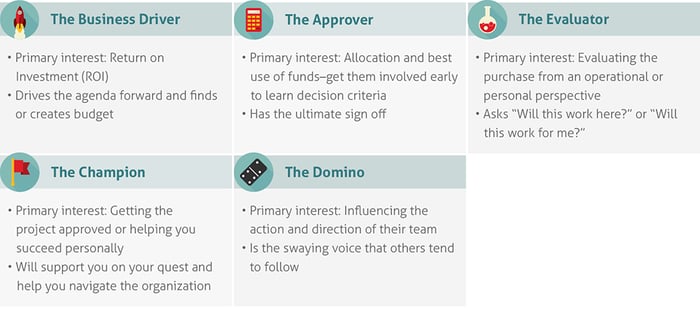"It was like a phantom swooped in in the eleventh hour and killed the sale."
We've all been there...You had a series of great meetings. You built rapport and developed a strong, trusted relationship. You uncovered (and got agreement) on the buyer's needs—needs that they didn't even know they had. You spent days working with your delivery team to scope the project and write the proposal. You sent it off to your contact and called him at the time you had scheduled to review it:
The Importance of Decision Roles
Buyer: "Thanks for putting this together. You've really hit the nail on the head outlining our company’s needs. I like the phase-by-phase approach you're proposing, allowing us to make adjustments along the way. I just need to have Brian take a look and give the green light."
You: "Wait. Brian? Who's Brian?"
Buyer: "Oh, Brian's our CTO. If we're going to move forward with the project, he'd be involved in the actual implementation and making sure it gets rolled out to all of our reps."
In complex B2B sales, most corporate buying decisions involve a core group of people who all have influence on the final outcome. They each bring their individual, and often differing, expectations and decision criteria.
They all have the power to kill the deal.
Identifying and interacting with this group—the buying team—is critical for both new sales and account growth. If you don't know who the buying team is early in the sale process, by the time you're further along it may be too late. You may find that your sale is upended because you didn't pay attention to one or more of these people.
How different people influence the sale depends on their decision roles. Here are the 5 core decision roles of the buying team that you need to sell to and how to succeed with each.

Meet the 5 Decision Roles
1. The Business Driver
This person is on a mission to create results and achieve a return on investment. Sellers tend to know right away that they must connect with the Business Driver, as they usually have the power to create room in the budget for any project they believe in. If your offering has the potential to be a profitable strategic leap for the company, the Business Driver can be the change agent who drives the agenda forward.
How to influence them: Business Drivers respond to a strong case for ROI—an impact story. You must demonstrate the value of what it is you do, and why you do it better than others. Sometimes this takes the form of a quantitative impact: a 20% return on investment, turnover reduced by 12%, productivity gains of 33%, and so on. However, it can also take the form of qualitative impact, such as the creation of a flexible work environment that builds culture, appeals to the team, and boosts morale.
Tip: Too often sellers focus their attention exclusively on the Business Drivers. Don't make this mistake. Uncover and interact with all the decision roles and you can gain a competitive advantage over the sellers who don't.
2. The Approver
The Business Driver may claim they have the authority and budget to buy, but they may still need to get someone else to sign off on it—the Approver. This role has the final say when it comes to approving the purchase. In some situations this may simply be a formality. In others, the Approver will actually make the ultimate "yes" or "no" decision based on more specific criteria.
How to influence them: The key is learn early on what criteria the Approver considers when it's time to give the go ahead. Do this by involving them and giving them a voice early in the sales process. Make them a part of the conversation.
Tip: You may face resistance from the Business Driver when it comes to inviting the Approver to the table. But even when the Driver believes the Approver is just going to quickly sign off on your sale at the last minute, it often turns out that doesn't happen. So it's worthwhile to make the case: "In my experience, it's helpful to get folks such as Brian in on the conversation early. I've been doing this for years and, often, questions come up that I'll be able to address right then and there, so you don't have to take time to track things down later. If we loop Brian in early, we can keep this process moving so you hit your implementation date."
3. The Evaluator
This role can be anyone who evaluates the purchase from an operational perspective—with an eye toward either how the solution relates to the organization, or how the decision will affect them, personally. Their job is to figure out what can go wrong, and to make sure that if something is bought, it will work for the company or will work for them.
For example, for a leadership development program, an Evaluator might say, "We use another company's method for leadership development. If we introduce a different method, it won't fit." Or, "We have multiple teams using this project management approach already. Introducing a new one will add complexity to our already-complex system."
How to influence them: Evaluators can get defensive and scuttle your sale if you leave them out of the process. Don't ignore them. The Business Driver might say, "Don't worry. I'll get Jane's buy-in on this." But, often, relying on the Business Driver to get the Evaluator's buy-in isn't enough. You should orchestrate and lead the process if you believe there's any chance they'll derail the sale.
Tip: Ask the Evaluator practical questions to avoid missing an opportunity for needs discovery. If you don't ask about their decision-making criteria, you could be disqualified for overlooking a hidden operational factor.
4. The Champion
This is the person who is going to support you on your quest. It could be a contact you already have a relationship with, or just someone who really wants to see this project move forward. Whatever the case, the champion is a powerful person to help you navigate through the organization. They could be the key to helping you discover what's most important to each of the buying team members.
Think about it in reverse: Ever lost a sale because the buyer had a prior relationship with a seller who swooped in at the end and won? It could have been the other seller had a Champion and you didn't, or the other Champion had more clout.
How to influence them: Too often, sellers don't take the time to look for a champion. There are most likely other people in the organization, even people who are only tangentially involved, who could be a real advocate to help you move forward. The best way to find them is to ask your contacts at the company, "Is there anyone else who might really like to see this happen?"
You could get invaluable aid in return: "You know, you should talk to Jill, our VP of sales. She might not even know this is happening but she can definitely give you some insight." And when you talk to Jill, you could learn a lot more. The Business Driver might be courting other providers, but you might be the only one who reaches out and talks to the VP of sales.
Tip: Ask if there's a pre-existing relationship in play. You might learn, for example, "Actually, yes, the VP of Operations worked with ACME Inc. at his last company and really wanted us to pull them into the process." You might not want to hear it, but it is important information. Now you can make a case for why you're the better choice.
5. The Domino
The fifth and final role is critically important, yet rarely discussed. This is the person (or two) in the sale who, should they bless the opportunity or you, the odds of you winning will greatly increase because others will follow their lead. In many complex sales, there's one person that if they say, "We should do this" or "We should do this with you," everything else falls into place.
How to influence them: In one sale we know of, there were 3 buyers in a staff function advocating for a purchase. They were Champions and Evaluators. The business leaders they were supporting were Business Drivers, looking to achieve great ROI. A big challenge for the seller, though, was that several of the Business Drivers had a preference for another provider.
One other senior executive was loosely involved in the process. She was a tangential Evaluator, who trusted her team to make decisions. In general, however, when she expresses a preference to make something a priority, or preference for a particular provider, everyone else tends to follow.
The sellers identified this person as The Domino. They worked tirelessly to arrange schedules and build a case for The Domino to attend an experience the seller had created for the buyers around their offering. After several weeks of effort, they got confirmation The Domino would attend.
At the end of the session, The Domino said to the core buying team, "This was great. Looking forward to seeing it all get underway and working with these folks."
What had been a 9 month process up to this point quickly turned to contracting. Two weeks later, the seller won the opportunity.
Tip: Whomever plays this role should receive special attention from you. See if you can get one-on-one time with them and inspire them with your solution, either by catering to their needs or creating a memorable, convincing experience like in the example above.
Depending on the size and structure of the company, you may find one person or multiple people playing these roles. The best way to identify them is simply to ask. The earlier you can involve all 5 buyer types, the better. They will want their own opportunity to voice their concerns and opinions, and you'll have ample time to ensure that the entire buying team's criteria are met.







